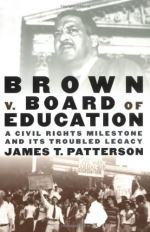|
This section contains 750 words (approx. 2 pages at 400 words per page) |

|
Summary
Marshall could not give up the fight against discrimination in schools. In 1950, he challenged the constitutionality of segregated public schools. The results a few years later would be Brown v. the Board of Education. Most of the early discrimination cases instituted by the Fund involved plaintiffs who were poorly education and poor. By the 1950s, Marshall was in a position to transform this early litigation into suits against segregation.
Lawsuits involved discrimination due to segregation in Delaware, Kansas, Washington, D.C., South Carolina and Virginia were brought by the fund and became the main players in Brown v. The Board of Education. The plaintiffs and their supporters for the most part took personal risks in deciding to participate in the legal proceedings. Many were parents just wanting their children to be treated fairly and have a brighter future...
(read more from the Chapter 2: The Grass Roots and Struggling Lawyers Summary)
|
This section contains 750 words (approx. 2 pages at 400 words per page) |

|




